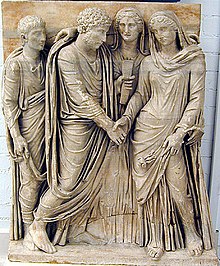Manus marriage

Manus (
In both cum manu and sine manu marriages, if both the husband and wife were
Initially, cum manu was the sole form of marriage, but eventually only sine manu marriage was widely practiced.[4]
Cum manu
In a cum manu union, the wife was released from the control of her father and became a member of her husband's family,
The wife in a cum manu marriage held no proprietary capacity, meaning she could not own any property.[1][3] Ownership of everything acquired prior to cum manu was transferred to her husband or his paterfamilias, while existing liabilities were erased. However, during the time of Cicero, the dowry was recognized as distinguishable and therefore recoverable.[3]
A
Cum manu was procured in one of three ways: confarreatio, coemptio and usus.[3]

Confarreatio
The ritual of
Coemptio
The matrimonial process of coemptio, in essence a
Usus
A cum manu acquired by usus was simply the
If the woman was not willing to come under the ownership of her husband, she could avoid manus by absenting herself for the total of three days and three nights before the end of each year.[8] A woman married cum manu through usus was emancipated upon divorce.[6]
The law of usus was eventually repealed, presumably because the practice had fallen out of use.[citation needed]
Sine manu
In a sine manu union, the wife legally and ritually remained a member of her father's family, standing under the control of her father's
It was only when the woman's paterfamilias died that she became sui iuris.[13] This union allowed the wife to become independent sooner than cum manu, under the assumption that the fathers are likely to have died before a husband. Primarily this served the natal family, allowing her property to stay in the father's possession.[14]
Various factors may have led to the extinction of cum manu and the predominance of sine manu during the Roman Republic. Women faced with the loss of property when entering a cum manu marriage began to only consent to sine manu unions.[4]
See also
References
- ^ a b c d e f g h Jane F. Gardner, Women in Roman Law and Society, First Midland Book Edition, 1991, 11
- ^ a b c John William Smith, John Innes Clark Hare, Horace Binny Wallace, John William Wallace, A selection of leading cases, on various branches of the law Law Booksellers and Publishers, 1855, Volume 2, 409
- ^ a b c d e f g h i j k l m n o Marcia L. Colish, The Stoic Tradition from Antiquity to the Early Middle Ages, Brill Academic Publishers, 1990, 2 Edition, 383
- ^ a b Rena Van den Bergh, "The Role of Education in the Social and Legal Position of Women in Roman Society", 11
- ^ Judith P. Hallett and Thoman Van Nortwick, Compromising Traditions, Routledge, 1997, 34
- ^ a b c d Susan Treggiari, Roman Marriage: Iusti Coniuges, Oxford University Press, 1993, 28
- ^ a b c Jane F. Gardner, Women in Roman Law and Society, First Midland Book Edition, 1991, 12
- ^ a b c d e f Judith Evans Grubbs, Women and the law in the Roman Empire: a sourcebook on marriage, divorce and widowhood, 2002 by Routledge, 22
- ^ Susan Treggiari, Roman Marriage: Iusti Coniuges, Oxford University Press, 1993, 23
- ^ a b c d e Susan Treggiari, Roman Marriage: Iusti Coniuges, Oxford University Press, 1993, 24
- ^ Jane F. Gardner, Women in Roman Law and Society, First Midland Book Edition, 1991, 13
- ^ John Peradotto and J.P. Sullivan, Women in the Ancient World: The Arethus Papers, State University of New York Press, 1984, 243
- ^ a b c Susan Treggiari, Roman Marriage: Iusti Coniuges, Oxford University Press, 1993, 32
- ^ Judith Evans Grubbs, Women and the law in the Roman Empire: a sourcebook on marriage, divorce and widowhood, 2002 by Routledge, 21
